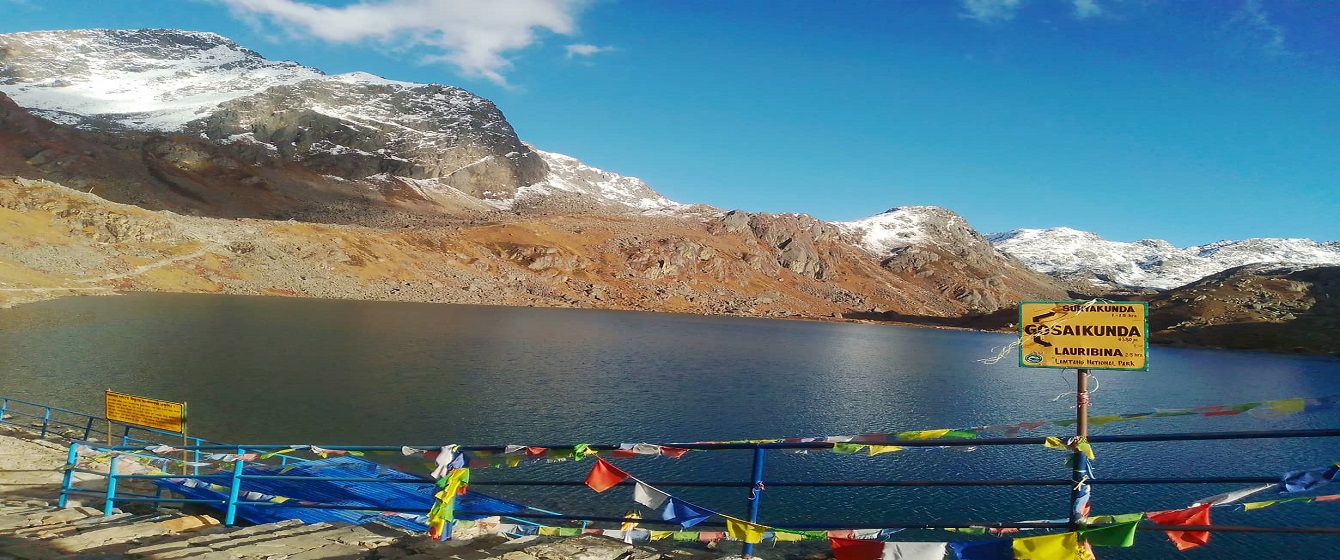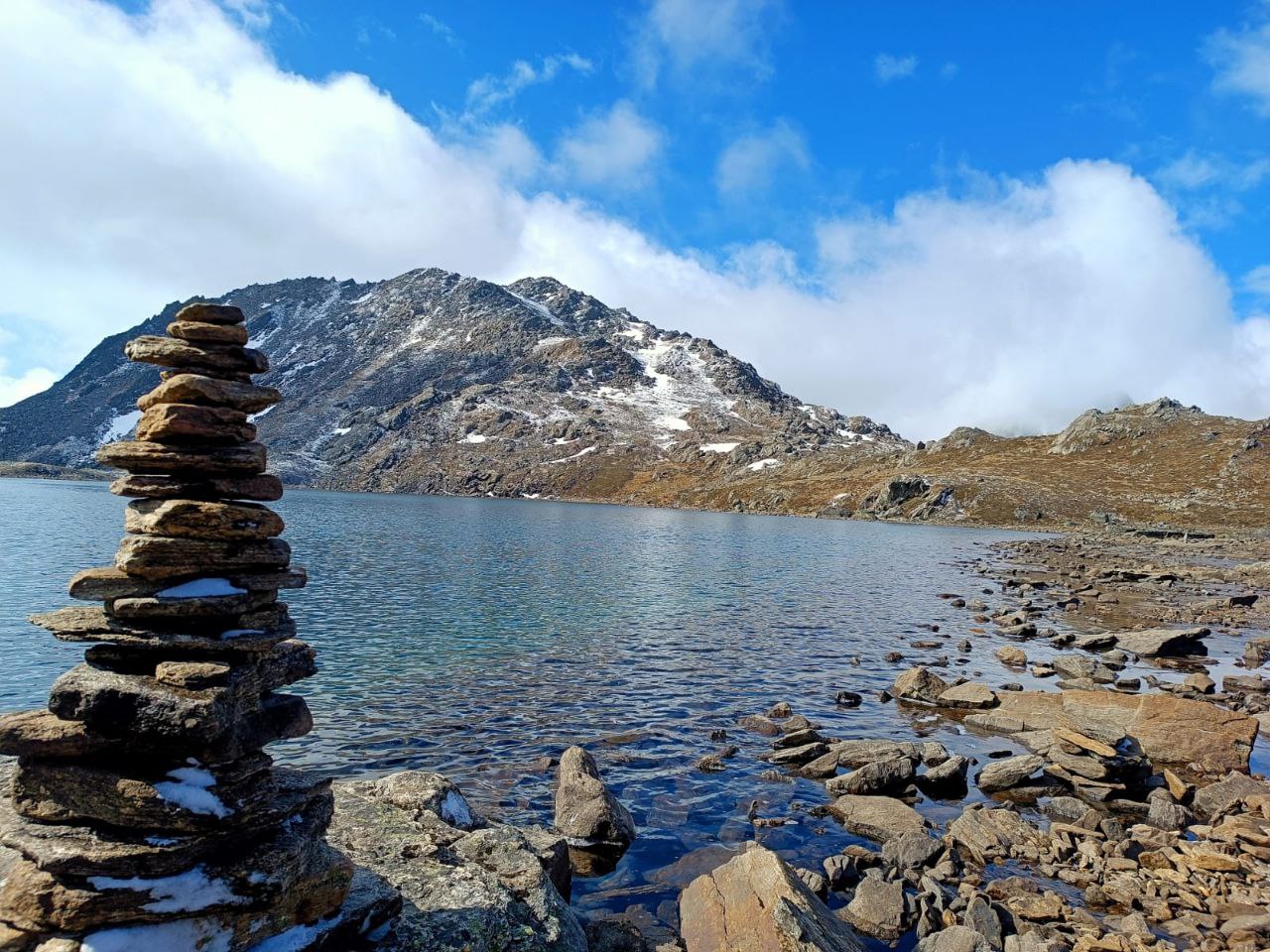Introduction: Gosainkunda Short Trek 2025-2026
Gosainkunda Short Trekking package takes you to high areas of Nepal Central Himalaya, located straight north of Kathmandu Valley within the Langtang Himal Range of Rasuwa district, regarded as the holiest of holy spots in all Himalaya regions.
Gosainkunda is a short adventure where you will be in a tranquil wilderness of high hills facing stunning views of a mountain range from Langtang-Ganesh-Jugal Himal as far towards Manaslu Range and Annapurna Range within the western direction.
Gosainkunda Short Trek begins with an exciting overland journey from Kathmandu to reach cooler areas at Dhunche the headquarters and administrative town of Rasuwa District and Langtang Himal Region, home to indigenous Tamang Tribes the hill people of Himalaya.
Where walk leads to a steep climb within serene woodland of tall rhododendron-magnolia-oaks-pines and fir trees to reach a small village at Singh Gompa also known as Chandanbari (Sandal-wood), from here heading much higher to cross over Laurabinayak ridge with an awesome panorama of peaks then reaching sacred Gosainkunda.
A famous pilgrimage site where Hindu followers visit for ritual bathing and dip in the icy pond, where belief delivers one into paradise and drink of its holy water relinquishes the sins of a hundred lifetimes, the pond with myth and history.
Around this sacred pond of Gosainkunda, where a great festival is held once a year during the auspicious time of Janai Purnima (Full Moon) in August, as per the Hindu Lunar calendar, according to another popular belief, a huge rock at the center of the pond remains hidden Shiva temple, at Gosainkunda enjoy the peaceful surrounding within great holy spirits site.
Enjoying perfect wilderness and pleasant scenic moments head downhill towards Dhunche past Sing Gompa for an interesting drive back to Kathmandu, after a remarkable experience and adventure on Gosainkunda short trek.

Why select Gosaikunda Short Trek?
Gosainkunda is a popular trekking route in the Langtang Region of Nepal. This trek is preferred by many trekkers because it provides a good balance between the time required to complete the trek and the opportunity to experience the stunning beauty of the Langtang Region.
On the way towards Gosainkunda, trekkers will walk through deep forests, picturesque landscapes, and remote areas with amazing views of the Himalayas. You will also be able to explore the distinct culture and way of life of the local communities of the particular region. The trek offers adequate time to enjoy the natural beauty and cultural experiences without feeling rushed.
Overall, the Gosainkunda Trekking is an excellent option for all those who wish to see the grandeur of the Langtang Region and the sacred Gosainkunda Lake.
Is Gosaikunda Trekking Right for you?
The short Gosainkunda trek is appropriate for anyone with normal fitness, previous trekking experience, and adequate time to complete the climb comfortably. The trek requires walking for several hours each day, with some steep ascents and descents, so physical endurance and stamina are required for the trek.
It is essential to keep calm and not rush at high altitudes. As the highest point of the trek is 4,336 meters above sea level, it might trigger altitude sickness in certain people. As a result, it is essential to allow enough time for acclimatization and to stay hydrated throughout the trek.
If you have any health problems or concerns, consulting with your doctor before beginning the trek can be really helpful. It is also recommended to book the trek through a reputable trekking company, as we can provide professional guides, porters, and medical help in case of necessity.
In summary, the Gosainkunda Journey is suitable for any individual with a moderate level of fitness, previous trekking experience, and the time to complete the trek comfortably. Trekkers who have consulted with the doctors can begin this trek at any point in the ideal season.
Best Season and month for Gosainkunda Trekking
The best seasons for this wonderful adventure from mid-spring and autumn times. From April to May and September to the second week of December months. April and May are lively seasons, days are clear for views and walks but can get colder by late afternoon till night and morning times. The next best season is September to the second week of December, days are bright with crystal clear blue sky. However, colder mornings and nighttime can expect snow sometimes during the walk to Gosainkunda Trekking.

Climate and Weather around Gosainkunda region
Depending on the season, around mid-spring, the weather is fine and clear, with more bright sunny days. It can get colder in the late afternoon and at night, as well as in the early morning. Before the sun sets, we reach the lodge to stay overnight. The temperatures range from a minimum of -05 °C to a maximum of 20 °C and above.
High altitude combined with bright sun and strong UV makes trekkers require sunscreen and sun hats. September to early November is bright and beautiful, although the sun sets late due to the autumn season. However, the day is fine and clear; it gets quite windy in the afternoon and frigid cold at night and in the morning. Minimum temperatures range from -10 °C to 20 °C. The sunlight is shorter during the autumn and gets dark soon, by 6 p.m.
NOTE: During the day, usually after 12:00pm - 1:00 pm, it gets pretty windy in the high altitudes, and the weather sometime changes suddenly with the wind at high altitudes.
Washing, Toilets and Accommodation facilities at gosainkunda trail
During the Gosainkunda trekking, you will stay in tea houses, which are simple lodges that provide lodging, meals, and some basic amenities.
- Washing: Normally, most tea houses and lodges provide basic washing facilities such as a bucket of hot water and soap for cleaning your face and hands. Some tea houses also provide a shower for an extra fee, but availability and quality may vary. So, it is suggested you bring sanitizers and face wipes as you may lack water in some areas.
- Toilets: The toilet facilities available in tea houses are simple and normally they consist of a squat toilet. As toilet paper may not be available always, it is best to carry your own. It is also essential to properly dispose of toilet paper, as the plumbing in the tea houses may not be capable of handling it.
- Accommodation: The tea houses provide basic lodging, including a bed and a blanket. As you rise to high elevation, the blankets may not be sufficient for you. So, for your warmth and comfort, you are advised to carry your sleeping bag. Sometimes in the peak season, you might have to share your accommodation with other trekkers, but Trekking Planner Nepal helps you with the pre-booking of your accommodation after you confirm your booking.
Is Travel Insurance Required for a short trek to Gosaikunda?
Trekking Planner Nepal strongly advises and recommends all the trekkers to purchase Insurance against though its not mandatory for unforeseen circumstances that might arise or occur. Travel and Medical Insurance can be obtained through World Nomads Travel Insurance for your upcoming holiday in Nepal Himalayan destinations. Having a travel insurance policy is always better while trekking to foreign countries and in the mountains, as sometimes we never know what will happen, so it's better to have a good policy than nothing.
Note: Travel insurance is not mandatory but can be beneficial and can help trekkers stay calm.
Why trekking planner nepal for gosainkunda trek?
All our hikes, trekking, and tour programs have itineraries where accommodations are all set in respective hotels, lodges, homestays, guest houses, and resorts, even camping in some remote areas as per the itinerary. We have been organizing trekking and helicopter tour activities for Gosainkunda on a private and group basis for the past 12 years. Our experienced team of guides, reservation officers, and event organizers makes the trip easy and hassle-free for all the trekkers.
Things to remember before beginning the trek?
- Some days could be longer or shorter, depending on the fitness of the clients.
- Availability of vehicles on time or traffic jams, flight delays, cancellations, unfavorable bad weather, and roads or trail conditions can lead to trek delays.
- In rare cases, we might even have to reroute or cancel the trips as per the political, riot, bad weather, broken road or trail condition, and porter's situation and condition.
- The company has the right to cancel the trips due to unavoidable conditions beyond our control.
Can we get altitude sickness during the trek?
Altitude sickness can affect anyone, even the most experienced trekkers and climbers, when trekking above 3200 meters. At high altitudes, the decrease in the layers of oxygen makes it harder to breathe. Mainly, it happens above 3200m (10,000ft). Signs and symptoms of altitude sickness are as follows:
- Headache/Dizziness.
- Nausea/vomiting.
- Tiredness/Fatigue.
- I'm sleepy but can’t sleep.
- Loss of appetite.
- Loss of taste in food
- Pain in the chest while breathing (stop immediately in this situation).
- Gasping and feeling hard to breathe with every step
Prevention for this is to dress warmly as per weather conditions, drink plenty of water, eat well, and walk slowly at your own pace. It is a good idea to climb a bit higher than you sleep elevation-wise. Stay hydrated, drink at least 3 liters of water per day, and make sure you avoid alcohol and tobacco during the trek.
Internet, Electricity and Battery Charging facilities
The accessibility of the internet, electricity, and battery charge depends on the location, season, altitude, and the lodges.
- Internet: Internet access is usually provided in all tea houses. While some tea establishments may have Wi-Fi, it may be slow and unreliable. As a result, it is advised to carry a local SIM card with a data plan. Some tea houses may provide the Wi-Fi facility but take extra charge for the use of the internet.
- Electricity: The tea houses along the Gosainkunda Trekking trail may not have consistent power, and power outages are common. As a result, it is advised to pack a portable power bank to keep your electronics charged. Some tea establishments may also provide charging facilities for an extra fee, but their availability and quality may vary. You are also requested to carry a headlamp as you may require it during the nighttime.
- Battery charge: The charging spots are available in the tea houses but they charge an extra amount for charging. You are advised to bring backup batteries or a power bank to keep your camera and other electrical gadgets charged. It is also essential to save battery power by turning off superfluous functions and leaving your devices in airplane mode when not in use.
In conclusion, while there may be no dependable internet or electricity available throughout the Gosainkunda trip, it is recommended that you bring a local SIM card, a portable power bank, and spare batteries to keep your electronics charged. You may capture and film the gorgeous surroundings and memories of your walk by being prepared and saving battery life
Outline Itinerary For Short Gosainkunda Trek
Day 1: Arrival in Kathmandu (1350m) and transfer to hotel.
Day 2: In Kathmandu with sightseeing tour and trek preparation.
Day 3: Drive to Dhunche (1,950 m) about 06 to 07 hrs drive hrs.
Day 4: Trek to Sing Gompa-Chandanbari (3,254 m) about 05 hrs walk.
Day 5: Trek to Gosainkund Lake (4,336 m) - 05 hrs.
Day 6: Trek to Dhunche (1,950 m) about 06 hrs and transfer to the lodge.
Day 7: Drive back to Kathmandu afternoon free at leisure.
Day 8: Depart Kathmandu for international flight home-ward bound



 General
General Upper Body
Upper Body Lower Body
Lower Body Other Essentials
Other Essentials


